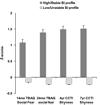Stable early maternal report of behavioral inhibition predicts lifetime social anxiety disorder in adolescence
- PMID: 19625982
- PMCID: PMC2789287
- DOI: 10.1097/CHI.0b013e3181ae09df
Stable early maternal report of behavioral inhibition predicts lifetime social anxiety disorder in adolescence
Abstract
Objective: Behavioral inhibition (BI), a temperamental style identifiable in early childhood, is considered a risk factor for the development of anxiety disorders, particularly social anxiety disorder (SAD). However, few studies examining this question have evaluated the stability of BI across multiple developmental time points and followed participants into adolescence-the developmental period during which risk for SAD onset is at its peak. The current study used a prospective longitudinal design to determine whether stable early BI predicted the presence of psychiatric disorders and continuous levels of social anxiety in adolescents. It was hypothesized that stable BI would predict the presence of adolescent psychiatric diagnoses, specifically SAD.
Method: Participants included 126 adolescents aged 14 to 16 years who were first recruited at 4 months of age from hospital birth records. Temperament was measured at multiple time points between the ages of 14 months and 7 years. In adolescence, diagnostic interviews were conducted with parents and adolescents, and continuous measures of adolescent- and parent-reported social anxiety were collected.
Results: Stable maternal-reported early BI was associated with 3.79 times increased odds of a lifetime SAD diagnosis, but not other diagnoses, during adolescence (95% confidence interval 1.18-12.12). Stable maternal-reported early BI also predicted independent adolescent and parent ratings of ongoing social anxiety symptoms.
Conclusions: Findings suggesting that stable maternal-reported early BI predicts lifetime SAD have important implications for the early identification and prevention of SAD.
Conflict of interest statement
Disclosure: Dr. Chronis-Tuscano has received funding from Ortho-McNeil-Janssen Pharmaceuticals to present findings based on a previous investigator-initiated trial. The other authors report no conflicts of interest.
Figures

References
-
- Fox NA, Henderson HA, Marshall PJ, Nichols KE, Ghera MM. Behavioral inhibition: linking biology and behavior within a developmental framework. Annu Rev Psychol. 2005;56:235–262. - PubMed
-
- Kagan J. Galen’s Prophecy. New York: Basic Books; 1994.
-
- Degnan KA, Fox NA. Behavioral inhibition and anxiety disorders: multiple levels of a resilience process. Dev Psychopathol. 2007;19:729–746. - PubMed
-
- Schmidt LA, Fox NA, Schulkin J, Gold PW. Behavioral and psycho-physiological correlates of self-presentation in temperamentally shy children. Dev Psychobiol. 1999;35:119–135. - PubMed
-
- Schmidt LA, Fox NA, Sternberg EM, Gold PW, Smith CC, Schulkin J. Adrenocortical reactivity and social competence in seven year-olds. Pers Individ Dif. 1999;26:977–985.
Publication types
MeSH terms
Grants and funding
LinkOut - more resources
Full Text Sources
Medical

